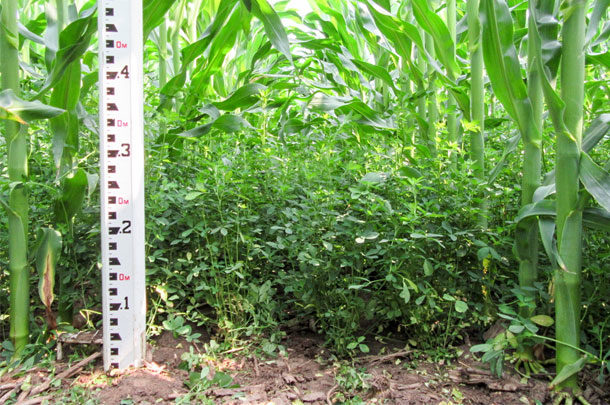The idea of interseeding corn and alfalfa has been tossed around by researchers and producers for decades. In perfect growing conditions, interseeding alfalfa with corn would enable producers to maximize the use of their cropland. Planting a crop of corn and alfalfa at the same time would give the alfalfa stand a full season to establish a strong root system without lessening the tonnage of the corn crop. Since yield from first-year alfalfa is paltry at best, leaving it to grow a full year would not only allow the stand to fully establish a root system, but it would also provide some ground cover against winterkill and start the next season at regular production rates.
Dan Schwartau, who runs a 470-cow dairy and farms 240 acres near Red Wing, Minnesota, planted alfalfa and corn together for three consecutive years before deciding to go back to his conventional planting schedule. Before planting he did some online research and worked closely with an agronomist to learn what would work best for him. They experimented with corn populations from 26,000 to 36,000 plants per acre.
The biggest problem Schwartau faced with interseeding corn and alfalfa was the stiff competition for sunlight between the corn and alfalfa. “The alfalfa is competing for light through the corn, and if I have too heavy of a stand of corn, the alfalfa will start to die off about a month before I get the corn harvested,” Schwartau says.
To prevent this, Schwartau tried backing off the population of the corn and putting in a flex-ear corn that, if the population of corn is lower, develops a bigger cob, which would keep the tonnage up on the corn silage side but hopefully let light in for the alfalfa. “You’re kind of trying to balance out by getting more tonnage of alfalfa the next year without losing too much corn silage that seeding year.”
If he had access to a growth inhibitor that he could use on the alfalfa to keep it from dying from lack of sunlight before taking the corn off, Schwartau says that he would definitely try interseeding corn and alfalfa again. “The nice thing about it, when it works, is that the yields on the hay fields the first production year are the same as my older stands that have been put in place two years before,” he says. “I like the fact that I am able to seed it at the same time as I plant corn in the spring and it gets a big root system developed by the time we take the corn off for silage.”
Forage researchers have been testing the viability of seeding corn and alfalfa for about 50 years, according to John Grabber, an agronomist with the U.S. Dairy Research Center in Wisconsin. Grabber says he started working on interseeding corn and alfalfa in 2008. Prior to 2008, he researched the possibility of other cover crops like red clover with silage corn. “With some of that work, I was trying to see if we could use these interseeded cover crops as a source of forage for the following year after corn, not just use them as a cover crop.” Grabber says they have run into the same problem with competition for sunlight, but that the experimental growth regulator they’re using really helps the alfalfa survive well under corn.
“The problem is always getting the two crops to live happily together rather than compete with each other,” Grabber says. “So we started testing growth regulators that we could apply to alfalfa to see if they might be useful to help the alfalfa to survive.” Grabber says they have found a few regulators that work well and are working with ag chemical companies to help the growth regulators be available for hay growers. “We’re really trying to promote that because we do believe that if farmers had that growth regulator as a tool that they could use, that a fair number of farmers would want to implement the system.”
Grabber says planting corn and alfalfa at the same time would also allow farmers to use conventional seeding equipment. “They can plant the corn with their normal drills and come back and over-seed the alfalfa.”
Grabber says delaying alfalfa seeding and planting alfalfa after the corn is already a foot tall would risk damaging the already planted corn and lessen the chance of successfully establishing the alfalfa stand. “We found that if you delay seeding alfalfa for very long, you greatly increase the risk of losing it because it just can’t compete with the corn.”
After looking at the interseeding system through an economic lens, Grabber says it is economically viable and could help farmers save money. “We think that because of the economics, because of the cover crop benefits, the ability to increase overall yield from corn and alfalfa rotations, we think that on a lot of farms it could be implemented. There are a lot of management aspects to refine to get the system to work as best as possible, so we’re trying to work out those details.” ![]()

-
Carrie Veselka
- Associate Editor
- Progressive Forage
- Email Carrie Veselka
PHOTO: Interseeded corn and alfalfa in early July. Photo provided by John Grabber.











